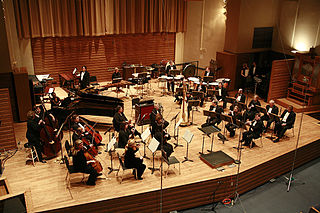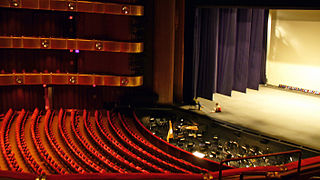 W
WAn orchestra is a large instrumental ensemble typical of classical music, which combines instruments from different families, includingbowed string instruments such as the violin, viola, cello, and double bass woodwinds such as the flute, oboe, clarinet, and bassoon brass instruments such as the horn, trumpet, trombone, and tuba percussion instruments such as the timpani, snare drum, bass drum, cymbals, triangle, tambourine, and mallet percussion instruments
 W
WA pit orchestra is a type of orchestra that accompanies performers in musicals, operas, ballets, and other shows involving music. The terms was also used for orchestras accompanying silent movies when more than a piano was used. In performances of operas and ballets, the pit orchestra is typically similar in size to a symphony orchestra, though it may contain smaller string and brass sections, depending upon the piece. Such orchestras may vary in size from approximately 30 musicians to as many as 90–100 musicians. However, because of financial, space, and volume concerns, the musical theatre pit orchestra in the 2000s is considerably smaller.
 W
WThe conductorless orchestra, sometimes referred to as a self-conducted orchestra or unconducted orchestra, is an instrumental ensemble that functions as an orchestra but is not led or directed by a conductor. Most conductorless orchestras are smaller in size, and generally perform chamber orchestra repertoire. Several conductorless orchestras are made up of only strings and focus primarily on string orchestra repertoire. Conductorless orchestras generally come from the classical music tradition and perform standard repertoire, but many conductorless orchestras promote or specialise in contemporary classical music repertoire. Many contemporary classical music ensembles also regularly perform without a conductor.
 W
WAn orchestra pit is the area in a theater in which musicians perform. Orchestral pits are utilized in forms of theatre that require music or in cases when incidental music is required. The conductor is typically positioned at the front of the orchestral pit facing the stage.
 W
WA rhythm section is a group of musicians within a music ensemble or band that provides the underlying rhythm, harmony and pulse of the accompaniment, providing a rhythmic and harmonic reference and "beat" for the rest of the band. The rhythm section is often contrasted with the roles of other musicians in the band, such as the lead guitarist or lead vocals whose primary job is to carry the melody.
 W
WString instruments, stringed instruments, or chordophones are musical instruments that produce sound from vibrating strings when a performer plays or sounds the strings in some manner.
 W
WA string orchestra is an orchestra consisting solely of a string section made up of the bowed strings used in Western Classical music. The instruments of such an orchestra are most often the following: the violin, which is divided into first and second violin players, the viola, the cello, and usually, but not always, the double bass.